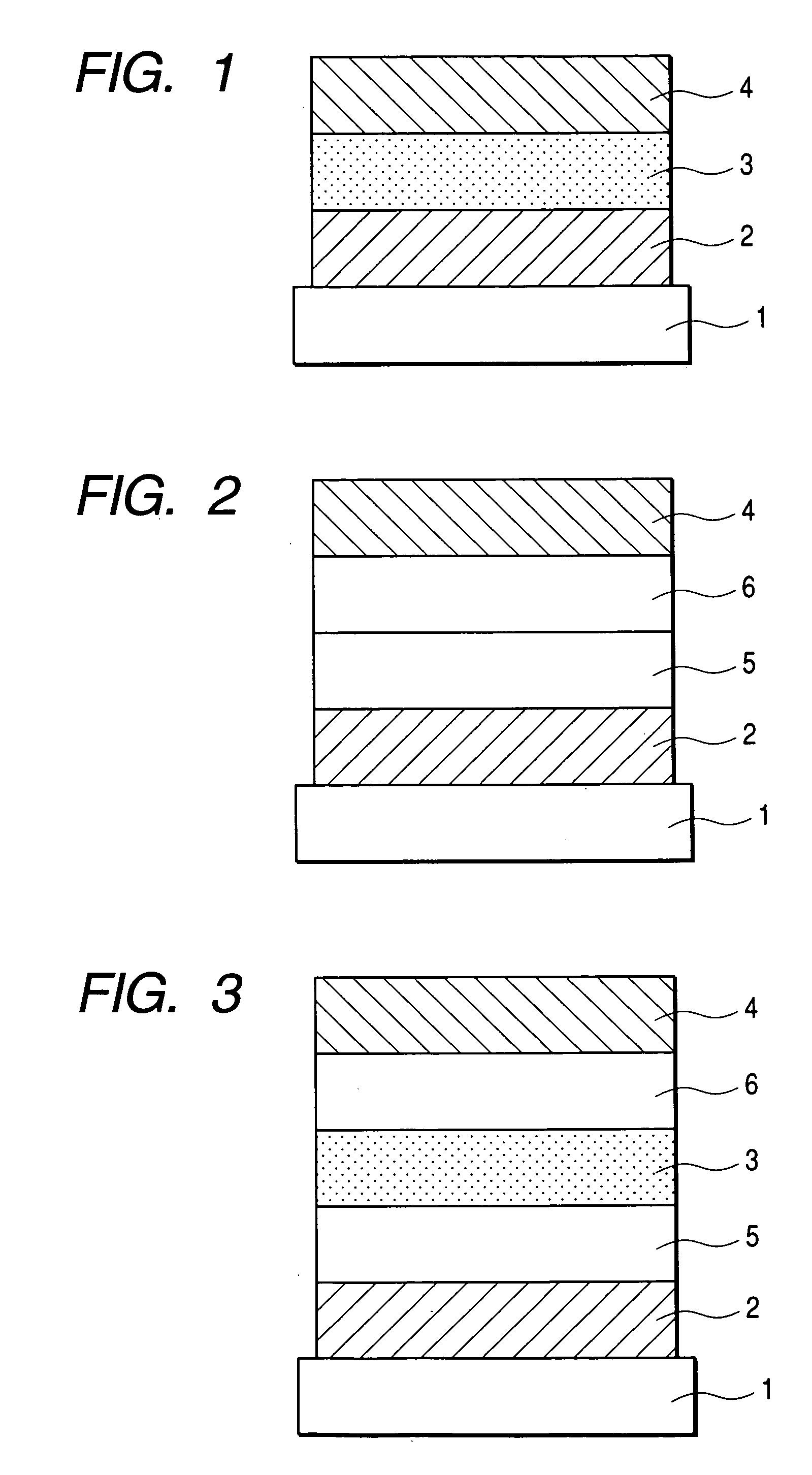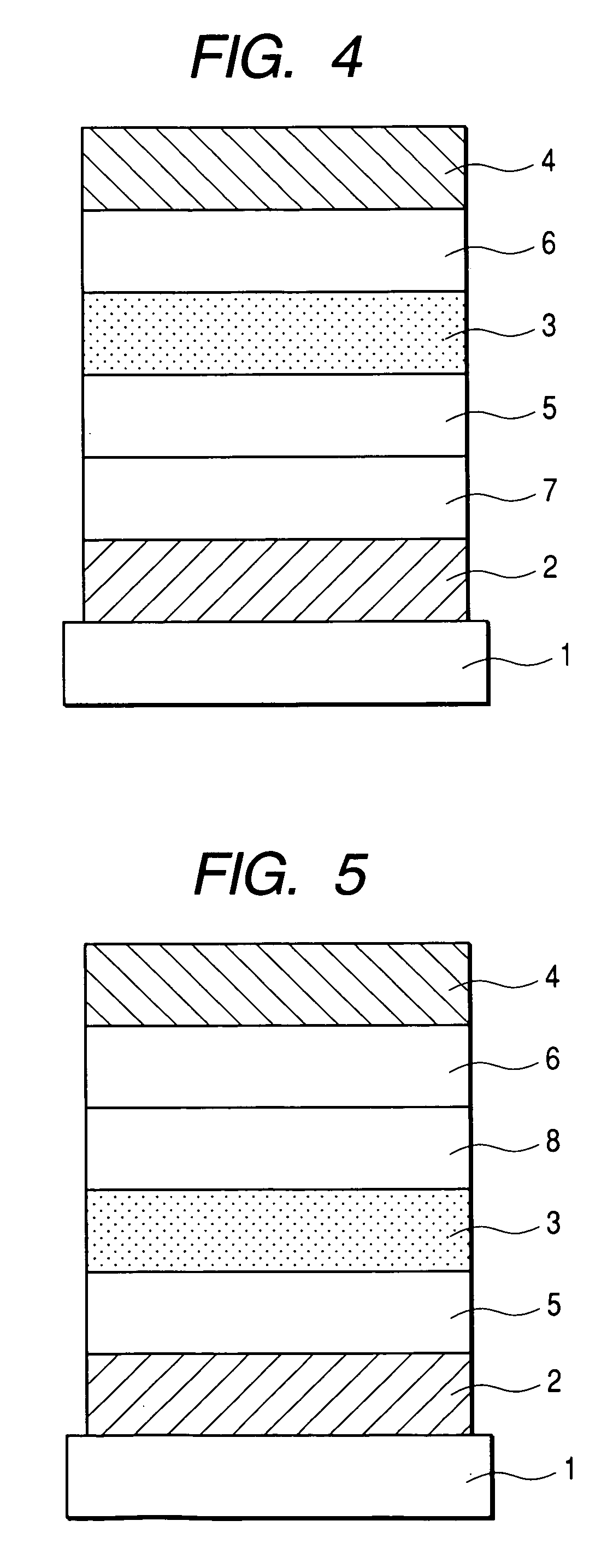Anthryl derivative group substituted compound, and organic luminescent device making use of same
a technology of anthryl derivative group and compound, which is applied in the direction of solid-state devices, light sources, domestic applications, etc., can solve the problems of long-time use and deterioration, low luminescence efficiency of devices, and insufficient practical use of luminescence efficiency and durability lifetime, etc., to achieve high luminescence efficiency, high purity, and high luminance
- Summary
- Abstract
- Description
- Claims
- Application Information
AI Technical Summary
Benefits of technology
Problems solved by technology
Method used
Image
Examples
example 1
[0124](Process of Producing Exemplary Compounds No. 15 and No. 34)
[0125]Synthesis of Intermediate (II):
[0126]
[0127]In a stream of nitrogen, 25.8 g (82 mmol) of tribromobenzene and 109.5 g (0.491 moles) of anthracene-9-boronic acid were dissolved in a mixed solvent of 1 L of deaerated toluene and 500 ml of ethanol and were stirred, followed by dropwise adding an aqueous sodium carbonate solution prepared by dissolving 86.9 g of anhydrous sodium carbonate in 800 ml of water. In a stream of nitrogen, the resulting solution was stirred for 1 hour on an oil bath heated to 80° C., and thereafter 14.2 g (12.3 mmol) of tetrakis(triphenylphosphine)palladium was added, followed by heating and stirring for about 4 hours on an oil bath heated to 80° C. The resultant reaction solution was cooled to room temperature and further cooled to 5° C., and crystals precipitated were filtered off. The crystals were dissolved in a chlorobenzene-heptane mixed solvent with heating and purified by silica gel ...
example 2
[0132](Process of Producing Exemplary Compounds No. 21 and No. 39)
[0133]
[0134]In a stream of nitrogen, 1.53 g (2 mmol, in terms of the dibromo-product) of the intermediate (II) and 1.90 g (6 mmol) of bis(4-methylphenyl)aminobenzene-4-boronic acid were dissolved in a mixed solvent of 180 ml of deaerated toluene and 90 ml of ethanol and were stirred, followed by dropwise adding an aqueous solution prepared by dissolving 0.98 g of anhydrous sodium carbonate in 30 ml of water. The resulting solution was stirred for 30 minutes, and thereafter 347 mg (0.3 mmol) of tetrakis(triphenylphosphine)palladium was added, followed by heating and stirring for about 5 hours on an oil bath heated to 80° C. The resultant reaction solution was cooled to room temperature, and thereafter 70 ml of water and 70 ml of ethyl acetate were added to separate a water layer and an organic layer. The water layer was extracted with toluene and ethyl acetate, and then combined with the previous organic layer, followe...
example 3
[0135](Process of Producing Exemplary Compound No. 40)
[0136]
[0137]Synthesis of Intermediate (IV):
[0138]A solution of 3 g (3.74 mmol) of the intermediate (III) in 120 ml of chloroform was cooled to 5° C., and 1.2 g (7.48 mmol) of bromine dissolved in 30 ml of chloroform was slowly dropwise added. After the dropwise addition, the resulting solution was stirred at room temperature for 2 hours, and 120 ml of methanol was further added, followed by stirring at 5° C. for 2 hours. The precipitate formed was filtered off, and the precipitate filtered was dispersedly washed with acetone. The resultant solution was cooled again to 5° C., and the precipitate was filtered off to produce 2.9 g of an intermediate (IV).
[0139]Synthesis of Exemplary Compound No. 40:
[0140]In a stream of nitrogen, 2 g (2.08 mmol) of the intermediate (IV) and 1.10 g (6.42 mmol) of naphthalene-2-boronic acid were dissolved in a mixed solvent of 150 ml of deaerated toluene and 30 ml of ethanol and were stirred, followed ...
PUM
| Property | Measurement | Unit |
|---|---|---|
| voltage | aaaaa | aaaaa |
| temperature | aaaaa | aaaaa |
| temperature | aaaaa | aaaaa |
Abstract
Description
Claims
Application Information
 Login to View More
Login to View More - R&D
- Intellectual Property
- Life Sciences
- Materials
- Tech Scout
- Unparalleled Data Quality
- Higher Quality Content
- 60% Fewer Hallucinations
Browse by: Latest US Patents, China's latest patents, Technical Efficacy Thesaurus, Application Domain, Technology Topic, Popular Technical Reports.
© 2025 PatSnap. All rights reserved.Legal|Privacy policy|Modern Slavery Act Transparency Statement|Sitemap|About US| Contact US: help@patsnap.com



